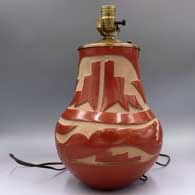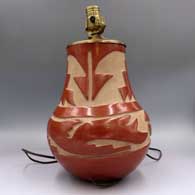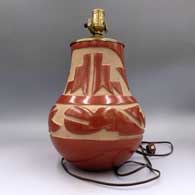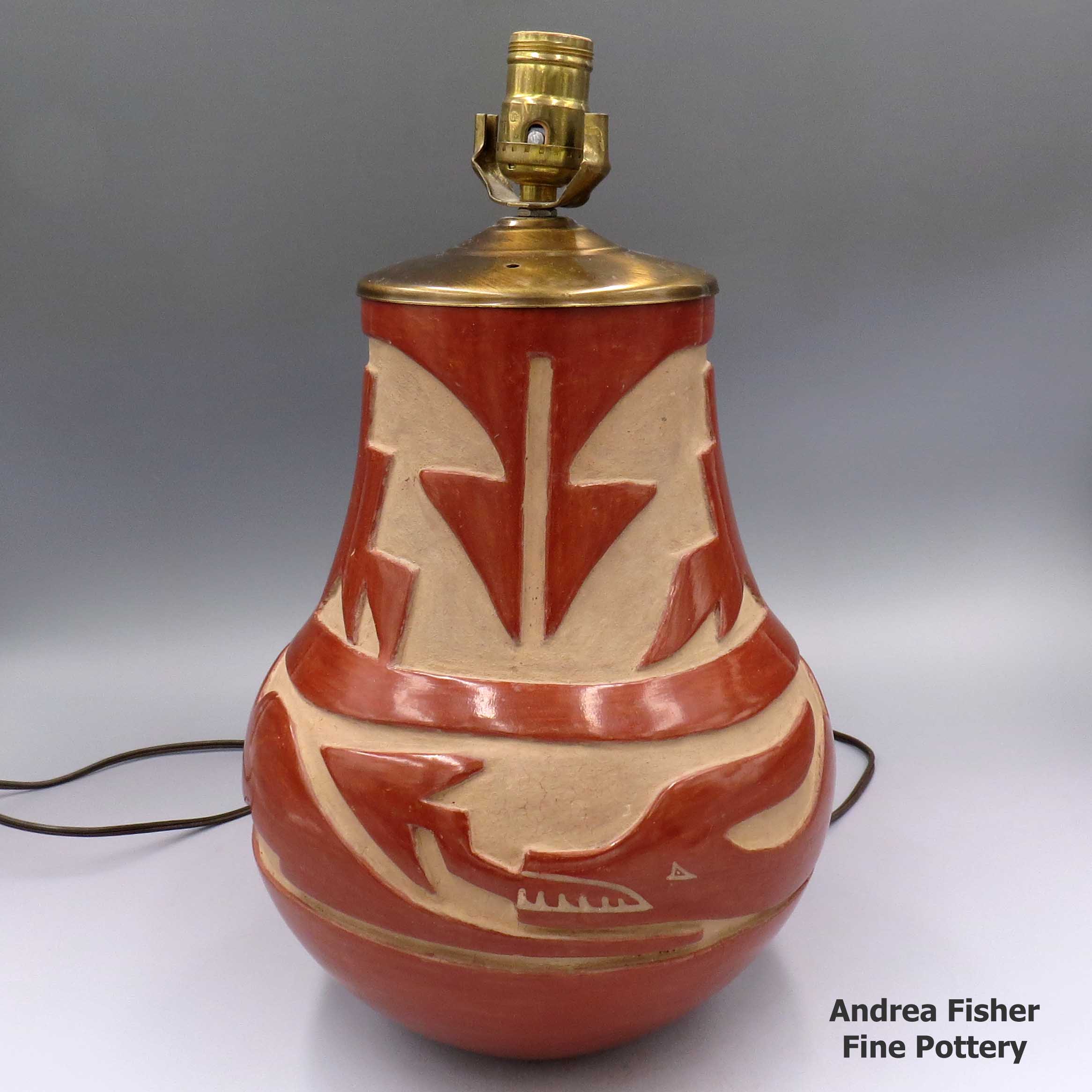
Santa Clara
$ 4800
zzsc1m682
Red jar carved with an avanyu and geometric design, drilled and mounted with lamp hardware
9.75 in L by 9.75 in W by 12.25 in H Measurement to top of jar only
Condition: Very good
Signature: Christina Naranjo
Sale Price: $2800
Tell me more! Buy this piece!
(505) 986-1234 - www.andreafisherpottery.com - All Rights Reserved
Christina Naranjo
Santa Clara1891-1980
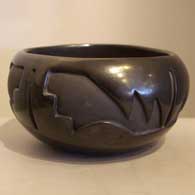
The eldest daughter of Sarafina and Geronimo Tafoya, Christina was Margaret Tafoya's older sister. Like Margaret, Christina learned the traditional way to make pottery from their mother. Eventually, she became the matriarch of her own branch of the Tafoya family tradition, passing her knowledge on to her daughters Mary Cain, Mida Tafoya, Teresita Naranjo and Cecilia Naranjo, and to numerous other members of her extended family. That tradition has now been passed down to further descendants including Autumn Borts, Linda Cain, Tammy Garcia, Sharon Naranjo Garcia and Sherry Tafoya.
Known for making traditional blackware and redware, Christina coiled, scraped, polished and carved many bowls, water jars, engagement baskets, wedding vases and candlestick holders. Her favorite designs to carve seem to have been kiva steps and the avanyu (the mythic Tewa water serpent). Like her mother Sarafina and sister Margaret, Christina made many larger pieces, larger than most being produced today.
Christina enjoyed making pottery so much that she was still working almost until the day she passed on.
Santa Clara Pueblo

Ruins at Puye Cliffs, Santa Clara Pueblo
Santa Clara Pueblo straddles the Rio Grande about 25 miles north of Santa Fe. Of all the pueblos, Santa Clara has the largest number of potters.
The ancestral roots of the Santa Clara people have been traced to the pueblos in the Mesa Verde region in southwestern Colorado. When that area began to get dry between about 1100 and 1300, some of the people migrated to the Chama River Valley and constructed Poshuouinge (about 3 miles south of what is now Abiquiu on the edge of the mesa above the Chama River). Eventually reaching two and three stories high with up to 700 rooms on the ground floor, Poshuouinge was inhabited from about 1375 to about 1475. Drought then again forced the people to move, some of them going to the area of Puye (on the eastern slopes of the Pajarito Plateau of the Jemez Mountains) and others to Ohkay Owingeh (San Juan Pueblo, along the Rio Grande). Beginning around 1580, drought forced the residents of the Puye area to relocate closer to the Rio Grande and they founded what we now know as Santa Clara Pueblo on the west bank of the river, between San Juan and San Ildefonso Pueblos.
In 1598 Spanish colonists from nearby Yunque (the seat of Spanish government near San Juan Pueblo) brought the first missionaries to Santa Clara. That led to the first mission church being built around 1622. However, the Santa Clarans chafed under the weight of Spanish rule like the other pueblos did and were in the forefront of the Pueblo Revolt of 1680. One pueblo resident, a mixed black and Tewa man named Domingo Naranjo, was one of the rebellion's ringleaders. When Don Diego de Vargas came back to the area in 1694, he found most of the Santa Clarans on top of nearby Black Mesa (with the people of San Ildefonso). An extended siege didn't subdue them so eventually, the two sides negotiated a treaty and the people returned to their pueblo. However, successive invasions and occupations by northern Europeans took their toll on the tribe over the next 250 years. The Spanish flu pandemic in 1918 almost wiped them out.
Today, Santa Clara Pueblo is home to as many as 2,600 people and they comprise probably the largest per capita number of artists of any North American tribe (estimates of the number of potters run as high as 1-in-4 residents).
Today's pottery from Santa Clara is typically either black or red. It is usually highly polished and designs might be deeply carved or etched ("sgraffito") into the pot's surface. The water serpent, ("avanyu"), is a traditional design motif of Santa Clara pottery. Another motif comes from the legend that a bear helped the people find water during a drought. The bear paw has appeared on their pottery ever since.
One of the reasons for the distinction this pueblo has received is because of the evolving artistry the potters have brought to the craft. Not only did this pueblo produce excellent black and redware, several notable innovations helped move pottery from the realm of utilitarian vessels into the domain of art. Different styles of polychrome redware emerged in the 1920's-1930's. In the early 1960's experiments with stone inlay, incising and double firing began. Modern potters have also extended the tradition with unusual shapes, slips and designs, illustrating what one Santa Clara potter said: "At Santa Clara, being non-traditional is the tradition." (This refers strictly to artistic expression; the method of creating pottery remains traditional).
Santa Clara Pueblo is home to a number of famous pottery families: Tafoya, Baca, Gutierrez, Naranjo, Suazo, Chavarria, Garcia, Vigil, Tapia - to name a few.



Santa Clara Pueblo at Wikipedia
Pueblos of the Rio Grande, Daniel Gibson, ISBN-13:978-1-887896-26-9, Rio Nuevo Publishers, 2001
Upper photo courtesy of Einar Kvaran, Creative Commons Attribution-Share Alike 3.0 Unported License
Christina Naranjo Family Tree
Disclaimer: This "family tree" is a best effort on our part to determine who the potters are in this family and arrange them in a generational order. The general information available is questionable so we have tried to show each of these diagrams to living members of each family to get their input and approval, too. This diagram is subject to change should we get better info.
- Christina Naranjo (1891-1980) & Jose Victor Naranjo (1895-1942)
- Mary Cain (1916-2010) & Willie Cain
- Billy Cain (1950-2005)
- Joy Cain (1947-)
- Linda Cain (1949-)
- Autumn Borts (1967-)
- Tammy Garcia (1969-)
- Tina Diaz (1946-)
- Warren Cain (1951-)
- Douglas Tafoya
- Marjorie Tafoya Tanin
- Mary Louise Eckleberry (1921-2003)
- Darlene Eckleberry
- Victor (1958-) & Naomi Eckleberry
- Teresita Naranjo (1919-1999)
- Mildred Moore (Naranjo, 1941-) & Victor Naranjo
- Eldon Moore
- Ernie Moore
- Kelli Moore
- Rick Moore
- Stella Chavarria (1939-)
- Denise Chavarria (1959-)
- Joey Chavarria (1964-1987)
- Sunday Chavarria (1963-)
- Mildred Moore (Naranjo, 1941-) & Victor Naranjo
- Cecilia Naranjo & James Lee McLean
- Sharon Naranjo Garcia (1951-) & Lawrence Atencio (San Juan)
- Ira Atencio (1975-)
- Lawrence Thunder Atencio
- Judy (1962-) & Lincoln Tafoya (1954-)
- Cecilia Fawn Tafoya (1986-)
- Chelsea Tafoya
- Eli Tafoya (1991-)
- Josetta Tafoya (1993-)
- Lincoln A. Tafoya (1989-)
- Linette Tafoya (1989-)
- Sarah Ayla Tafoya (1987-)
- Sharon Naranjo Garcia (1951-) & Lawrence Atencio (San Juan)
- Mida Tafoya (1931-)
- Ethel Vigil (1950-)
- Kimberly Garcia (1978-)
- Mike Tafoya (1956-)
- Phyllis Tafoya (1955-) & Matthew Tafoya
- Sherry Tafoya (1956-)
- Phyllis & Marlin Hemlock (Seneca)
- Lincoln Tafoya (1954-)
- Matthew Tafoya (1953-)
- Ethel Vigil (1950-)
- Edward Mickey Naranjo and Gracie Naranjo (Navajo)
- Edward Mickey Naranjo Jr.
- Teresa Naranjo
- Tracy Naranjo
Some of the above info is drawn from Pueblo Indian Pottery, 750 Artist Biographies, by Gregory Schaaf, © 2000, Center for Indigenous Arts & Studies. Other info is derived from personal contacts with family members and through interminable searches of the Internet.
Copyright © 1998-2024 by


